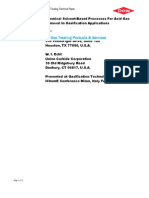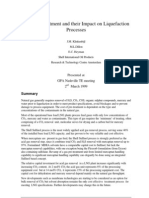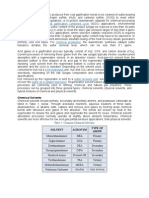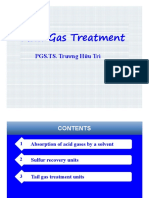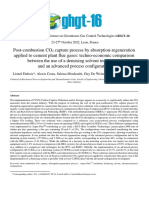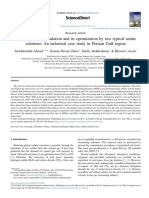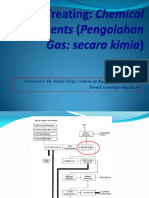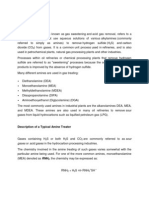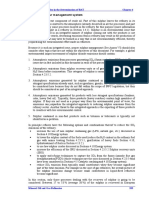Gas Sweetening Processes: Aqueous Solution Wt. % Mole % Mdea 50 13.13 H2O 50 86.87 Total 100 100.00
Gas Sweetening Processes: Aqueous Solution Wt. % Mole % Mdea 50 13.13 H2O 50 86.87 Total 100 100.00
Uploaded by
AjaykumarCopyright:
Available Formats
Gas Sweetening Processes: Aqueous Solution Wt. % Mole % Mdea 50 13.13 H2O 50 86.87 Total 100 100.00
Gas Sweetening Processes: Aqueous Solution Wt. % Mole % Mdea 50 13.13 H2O 50 86.87 Total 100 100.00
Uploaded by
AjaykumarOriginal Title
Copyright
Available Formats
Share this document
Did you find this document useful?
Is this content inappropriate?
Copyright:
Available Formats
Gas Sweetening Processes: Aqueous Solution Wt. % Mole % Mdea 50 13.13 H2O 50 86.87 Total 100 100.00
Gas Sweetening Processes: Aqueous Solution Wt. % Mole % Mdea 50 13.13 H2O 50 86.87 Total 100 100.00
Uploaded by
AjaykumarCopyright:
Available Formats
"OIL AND GAS PROCESSING PLANT DESIGN 2002
AND OPERATION TRAINING COURSE"
Page 21
DGEP/SCR/ED/ECP "GAS SWEETENING PROCESSES"
Conversely MDEA is also interesting for the bulk removal of CO2 due to its low heat of reaction
with this compound (energy saving at the level of the regeneration section). Generic MDEA is
available on the market of chemical products (HUNTSMAN for instance) but almost all processes
based on the use of MDEA are from licensers. Licensers add activated agents to the MDEA to suit
the type of acid gas removal requirements.
Main licensers of MDEA-based processes are :
BASF : Activated MDEA (aMDEA). The first industrial plant was built in 1971. Now,
there are 80 worldwide references (22 % in Natural gas). The activated agent,
Piperazin, is added to the MDEA.
DOW CHEMICAL : Gas-Spec Process using an activated MDEA derived product (Gas
Spec SS Selective Solvent) originally preferably used for the selective removal of H2S
with high CO2 slippage percentages: % slippage = 100 x (Outlet gas CO2 content/Inlet
Gas CO2 content).
The formulation of the solvent is such that it can be also used for controlled CO2
removal (CS-3 MDEA solvent) to adjust the GCV of an export gas.
EE(P) : Activated MDEA process (see figure XI-B.9). The activated agent added to the
MDEA is adapted to the type of contaminant to be preferably removed. The specific
feature of this design is that a small portion of the rich amine solution is regenerated in
the conventional regeneration section (with a fractionation column with reboiler and
condenser). The rest of the rich solution is regenerated by multi-stage (generally 2
stages) flash separation (semi-lean solution).
UOP : Amine Guard process (see figure XI-B.10) using generic MDEA and a collection
of so-called Ucarsol solvents (fabricated by UOP and designed for selective removal
of H2S, deep removal of both H2S and CO2, removal of CO2 from H2S free feed gas).
Concentration
Pure MDEA is generally used in aqueous solutions with concentrations between 35 and 50 Wt. %.
The molar composition of a 50 Wt. % MDEA solution is as follows:
Aqueous Solution Wt. % Mole %
MDEA 50 13.13
H2O 50 86.87
total 100 100.00
Excerpt from PRODEM
"OIL AND GAS PROCESSING PLANT DESIGN 2002
AND OPERATION TRAINING COURSE"
Page 22
DGEP/SCR/ED/ECP "GAS SWEETENING PROCESSES"
Utilization
Generic MDEA is used to remove selectively H2S (down to 4 ppm V and even lower) from a feed
gas containing both CO2 and H2S (CO2 slippage: 60 to 80 %). Activated MDEA (through
licensers) can be used for deep removal of both H2S and CO2 (to satisfy a LNG specification for
instance).
When CO2 is the sole gas contaminant, bulk removal can be realized with generic MDEA but this
would require higher circulation rates than with primary and secondary amines (thermal energy,
however would be lower). For deep removal of CO2, activated MDEA from licensers will be
required.
Chemical reaction
- H2S
H2S reacts immediately with MDEA.
R2NCH3 + H2S R2NHCH3HS
- CO2
MDEA being a tertiary amine, the molecule does not have an hydrogen atom attached directly to
the nitrogen atom. This has an important impact on the chemistry of CO2/MDEA reaction. The
carbamate formation which is important for primary and secondary amines is inhibited and the
bicarbonate formation (easy to remove from the rich solution to reconstitute a poorly CO2 loaded
lean solution) becomes the only important reaction.
R2NCH3 + CO2 + H2O R2NHCH3HCO3
where R= C2H4OH
The above reactions are reversible.
MDEA Solution Loading
For generic MDEA solutions free from licenser’s processes, the gross acid gas pick-up must
remain below 0.45 mole/mole of pure MDEA to avoid corrosion.
The lean solution CO2 loading is around 0.01 mole CO2/mole pure solvent.
Other sound amine process : Hindered Amine
EXXON is a licenser for processes (Flexorb processes) using formulated amines (hindered
amines). The solvent (based on alkanolamine) is formulated according to the acid gas pick-up
requirements. The different type of processes are as follows :
Flexorb SE (commercially available since 1983) for the selective removal of H2S
Flexorb PS (available since 1984) for both removal of H2S and CO2 (and COS). In this
case, the formation of stable carbamate with CO2 and classical primary and secondary
amines (which limit the acid gas pick-up to 0.45/0.5 mole of CO2/mole of pure amine) is
reduced. According to EXXON tests, Flexorb agent also offers a capacity advantage over
MDEA.
Excerpt from PRODEM
"OIL AND GAS PROCESSING PLANT DESIGN 2002
AND OPERATION TRAINING COURSE"
Page 23
DGEP/SCR/ED/ECP "GAS SWEETENING PROCESSES"
Flexorb HP for removal of CO2 when the feed gas is free from H2S.
Remark: When dealing with a licenser, for any kind of gas sweetening study (feasibility study, pre-
project, basic engineering), a secrecy agreement has to be signed between the Company and the
licenser and then the licenser will start the requested work and disclose the features of its design
(process flow diagram, material balance, utility balance, preliminary sizing of the major equipment,
cost of solvent, inventory, chemical consumption’s).
A licensing fee is then requested by the licenser when a firm contract is signed between the
Company and the licenser.
2.1.7. Potassium Carbonate
Potassium carbonate (K2CO3) is an alkaline salt which is used for the removal of acid gas. At
ambient condition, Potassium carbonate is under solid form. It is used in aqueous solution. In order
to keep the carbonate dissolved in the water, the solution must be kept under temperature (more
than 60 deg.C for a 30 Wt. % carbonate solution).
Unlike amine solutions, Potassium carbonate solution is not susceptible to oxygen contamination.
The product is available on the market but processes based on its use are developed by licensers.
The major licenser is UOP with the Benfield processes which have the largest number of industrial
references in natural gas sweetening.
CATACARB process is also based on Potassium carbonate but with less industrial reference.
Concentration
Potassium carbonate is used in aqueous solutions with concentrations around 30 Wt. % (molecular
weight of Potassium carbonate is 138.2).
The molar composition of a 30 Wt. % HPC solution is as follows:
Aqueous Solution Wt. % Mole %
Potassium Carbonate 30 5.29
H2O 70 94.71
total 100 100.00
Chemical reaction
- H2S
The chemical reaction with H2S is as follows :
K2CO3 + H2S KHS + KHCO3
The absorption reaction is exothermic : Heat of reaction of K2CO3 with H2S is 22 BTU/SCF (819
kJ/Sm3 of H2S).
The Potassium bisulfide (KHS) is very difficult to regenerate so the Hot Pot process is not suitable
for sweetening gas mixtures containing little or no CO2.
Excerpt from PRODEM
You might also like
- Examiner and Learner Guide For Scheduled MinesDocument84 pagesExaminer and Learner Guide For Scheduled MinesCollen100% (4)
- Safety Officer Saudi Aramco Questions and Answers PDF - HSE OFFICER Saudi Aramco Questions and Answers PDFDocument23 pagesSafety Officer Saudi Aramco Questions and Answers PDF - HSE OFFICER Saudi Aramco Questions and Answers PDFQasim Awan100% (10)
- Confined Space Entry ChecklistDocument1 pageConfined Space Entry ChecklistHaleemUrRashidBangash100% (3)
- Design Guidelines For Amine PlantsDocument21 pagesDesign Guidelines For Amine Plantsargacho100% (3)
- MSA SDS Calibration Check GasDocument11 pagesMSA SDS Calibration Check GasJuan ChajuNo ratings yet
- H2S Training Slides (ENGLISH)Document46 pagesH2S Training Slides (ENGLISH)Khaled Ismail100% (7)
- Gas Sweetening ProcessesDocument5 pagesGas Sweetening ProcessesAjaykumarNo ratings yet
- Gas Sweetening ProcessesDocument4 pagesGas Sweetening ProcessesAjaykumarNo ratings yet
- Acid Gas RemovalDocument13 pagesAcid Gas RemovalSu Yen Yap100% (1)
- Gas Pre TreatmentDocument12 pagesGas Pre TreatmentAnonymous bHh1L1100% (4)
- Acid Gas Cleaning Using Amine SolventsDocument20 pagesAcid Gas Cleaning Using Amine SolventsGEORGEVPAUL_14565666No ratings yet
- Simulation and Optimization of Gas Sweetening ProcessDocument20 pagesSimulation and Optimization of Gas Sweetening ProcessAhmed ShaepNo ratings yet
- Natural Gas Plant Debottlenecking Thanks To Hybrid SolventDocument12 pagesNatural Gas Plant Debottlenecking Thanks To Hybrid Solventandrey.glinskyNo ratings yet
- Acid Gas RemovalDocument18 pagesAcid Gas RemovalKailash NarainNo ratings yet
- Taylor CraigDocument11 pagesTaylor CraigPhani KumarNo ratings yet
- MdeaDocument28 pagesMdeahaarika1006100% (3)
- Simulation of Loading Capacity of MDEA and DEA For Amine-Based CO Removal Using HysysDocument6 pagesSimulation of Loading Capacity of MDEA and DEA For Amine-Based CO Removal Using HysysZack AmerNo ratings yet
- 2 - Acid Gas TreatmentDocument73 pages2 - Acid Gas TreatmentAn Lê TrườngNo ratings yet
- Gas SweeteningDocument3 pagesGas SweeteningAleem AhmedNo ratings yet
- Sulfur Compound Extraction and Sweetening: P A R T 11Document14 pagesSulfur Compound Extraction and Sweetening: P A R T 11Bharavi K SNo ratings yet
- DEA - PZ and DEEA - MAPA ProcessDocument11 pagesDEA - PZ and DEEA - MAPA ProcessMaythee SaisriyootNo ratings yet
- Treating Technologies of Shell Global Solutions For Natural Gas and Refinery Gas StreamsDocument19 pagesTreating Technologies of Shell Global Solutions For Natural Gas and Refinery Gas StreamsPrasad ChakkrapaniNo ratings yet
- Ammonia: Concept and ApplicationDocument23 pagesAmmonia: Concept and Applicationgetahun esubalewNo ratings yet
- Surge Tank: Gas Sweetening ProcessesDocument5 pagesSurge Tank: Gas Sweetening ProcessesAjaykumarNo ratings yet
- 0901 B 803800391 e 2Document15 pages0901 B 803800391 e 2Jack SutherlandNo ratings yet
- Integrated Gasification Combined Cycle: Acid Gas RemovalDocument3 pagesIntegrated Gasification Combined Cycle: Acid Gas RemovaljuhriloverNo ratings yet
- Gas Sweetening Simulation and Its Optimization by Two Typical AmineDocument8 pagesGas Sweetening Simulation and Its Optimization by Two Typical AmineYogesh PatilNo ratings yet
- Carbonyl PDFDocument7 pagesCarbonyl PDFscribd_alphaNo ratings yet
- At 05415 WP Acid Gas Cleaning Using Amine Solvents 2019 1125Document63 pagesAt 05415 WP Acid Gas Cleaning Using Amine Solvents 2019 1125Muhammad NaeemNo ratings yet
- Gorset 2014Document14 pagesGorset 2014nurzatil.othmanNo ratings yet
- Types of Alkanolamines For Acid Gas Treatment 1709355394Document4 pagesTypes of Alkanolamines For Acid Gas Treatment 1709355394MohammadAminNo ratings yet
- Natural Gas Sweetening & Effect of Decline PressureDocument29 pagesNatural Gas Sweetening & Effect of Decline Pressureromdhan88No ratings yet
- Amine Gas Treating: Description of A Typical Amine TreaterDocument4 pagesAmine Gas Treating: Description of A Typical Amine TreaterjfkdlsjsakNo ratings yet
- Improve Scrubbing DesignDocument5 pagesImprove Scrubbing Designtrong40No ratings yet
- Clean Hydrogen Production From SMR International Conf CO2 SummitDocument7 pagesClean Hydrogen Production From SMR International Conf CO2 Summitdavid alonzoNo ratings yet
- 10.1002 Cjce.25217 msr5Document13 pages10.1002 Cjce.25217 msr5aazmachamicalNo ratings yet
- ADIP RefineryDocument2 pagesADIP RefineryVenkatesh Kumar RamanujamNo ratings yet
- Natural Gas SweeteningDocument153 pagesNatural Gas SweeteningBakhtyar AhmedNo ratings yet
- Gas Treatment Processes-1Document17 pagesGas Treatment Processes-1m sohailNo ratings yet
- Gas TreatmentDocument60 pagesGas TreatmentMusab AhmedNo ratings yet
- Contactor Vol_16 No_04 (Cleaning Landfill Gas)Document2 pagesContactor Vol_16 No_04 (Cleaning Landfill Gas)Sopir GojekNo ratings yet
- Gas SweeteningDocument43 pagesGas Sweeteningwaheed100% (1)
- "Oil and Gas Processing Plant Design and Operation Training Course" " " 2002Document10 pages"Oil and Gas Processing Plant Design and Operation Training Course" " " 2002AjaykumarNo ratings yet
- AGRU Process Simulation Using MDEADocument10 pagesAGRU Process Simulation Using MDEAsabirNo ratings yet
- Seminar 00017Document22 pagesSeminar 00017Mohammad HamzaNo ratings yet
- Amine Gas TreatingDocument3 pagesAmine Gas Treatinghmudassir_1No ratings yet
- Gas Sweetening ProcessesDocument1 pageGas Sweetening ProcessesAjaykumarNo ratings yet
- A1113 PDFDocument3 pagesA1113 PDFAjaykumarNo ratings yet
- Co 2 RevspDocument7 pagesCo 2 RevspNeima DoualehNo ratings yet
- Adva MineDocument2 pagesAdva MineEdgard GonzalesNo ratings yet
- Amine Gas Treating: Gases or Acid Gases in The Hydrocarbon Processing IndustriesDocument4 pagesAmine Gas Treating: Gases or Acid Gases in The Hydrocarbon Processing IndustriesikatparNo ratings yet
- The Use of MDEA and Mixtures of Amines For Bulk CO2 RemovalDocument9 pagesThe Use of MDEA and Mixtures of Amines For Bulk CO2 RemovalTrùm Dầu Mỏ BkNo ratings yet
- 4.23.5 Sulphur Management SystemDocument16 pages4.23.5 Sulphur Management SystemVictor VazquezNo ratings yet
- Carbondioxide ScrubberDocument8 pagesCarbondioxide ScrubberSameer ChalkeNo ratings yet
- Industrial Design and Optimization of Co2 Capture, Dehydration, and Compression Facilities PDFDocument11 pagesIndustrial Design and Optimization of Co2 Capture, Dehydration, and Compression Facilities PDFMmediong Udofia100% (2)
- DMT Making Pressurized Water ScrubbingDocument9 pagesDMT Making Pressurized Water Scrubbingcheme2No ratings yet
- CO2 RemovalDocument8 pagesCO2 RemovalVinh PhamthanhNo ratings yet
- 1 5017252105082110359 PDFDocument16 pages1 5017252105082110359 PDFAnthony PintoNo ratings yet
- Nitrogeoin Rejection Technology For Abu DhabiDocument10 pagesNitrogeoin Rejection Technology For Abu DhabiBeshuoNo ratings yet
- SulphurRecovery PDFDocument22 pagesSulphurRecovery PDFfatamorgganaNo ratings yet
- Process Systems and Materials for CO2 Capture: Modelling, Design, Control and IntegrationFrom EverandProcess Systems and Materials for CO2 Capture: Modelling, Design, Control and IntegrationAthanasios I. PapadopoulosNo ratings yet
- Clean Ironmaking and Steelmaking Processes: Efficient Technologies for Greenhouse Emissions AbatementFrom EverandClean Ironmaking and Steelmaking Processes: Efficient Technologies for Greenhouse Emissions AbatementNo ratings yet
- Cutting-Edge Technology for Carbon Capture, Utilization, and StorageFrom EverandCutting-Edge Technology for Carbon Capture, Utilization, and StorageKarine Ballerat-BusserollesNo ratings yet
- Synthetic Natural Gas: From Coal, Dry Biomass, and Power-to-Gas ApplicationsFrom EverandSynthetic Natural Gas: From Coal, Dry Biomass, and Power-to-Gas ApplicationsTilman J. SchildhauerNo ratings yet
- Gas Sweetening ProcessesDocument1 pageGas Sweetening ProcessesAjaykumarNo ratings yet
- Gas Sweetening Processes: 3. BibliographyDocument1 pageGas Sweetening Processes: 3. BibliographyAjaykumarNo ratings yet
- Gas Sweetening ProcessesDocument9 pagesGas Sweetening ProcessesAjaykumarNo ratings yet
- A1114 PDFDocument4 pagesA1114 PDFAjaykumarNo ratings yet
- A1113 PDFDocument3 pagesA1113 PDFAjaykumarNo ratings yet
- A1112 PDFDocument3 pagesA1112 PDFAjaykumarNo ratings yet
- PONA Analysis On AB-PONA ColumnDocument7 pagesPONA Analysis On AB-PONA ColumnAjaykumarNo ratings yet
- "Oil and Gas Processing Plant Design and Operation Training Course" " " 2002Document10 pages"Oil and Gas Processing Plant Design and Operation Training Course" " " 2002AjaykumarNo ratings yet
- Total/Uop Olefin Cracking Process: EthyleneDocument1 pageTotal/Uop Olefin Cracking Process: EthyleneAjaykumarNo ratings yet
- Student Lecture 11 Field Processing and Treatment of Natural GasDocument38 pagesStudent Lecture 11 Field Processing and Treatment of Natural GasAjaykumarNo ratings yet
- Polypropylene: PERP 2011-5Document6 pagesPolypropylene: PERP 2011-5AjaykumarNo ratings yet
- Annajaf City Naphtha As A Commercial Alternative Fuel For S.I. Engines in IraqDocument10 pagesAnnajaf City Naphtha As A Commercial Alternative Fuel For S.I. Engines in IraqAjaykumarNo ratings yet
- The Star Process by Uhde: Industrial SolutionsDocument24 pagesThe Star Process by Uhde: Industrial SolutionsAjaykumarNo ratings yet
- Utility Esitmate For SpheripolDocument5 pagesUtility Esitmate For SpheripolAjaykumarNo ratings yet
- Supervisory Operating Manual: UNIT NO.: 07 (Amine 2) Amine Regeneration Unit Cartagena Refinery Expansion ProjectDocument113 pagesSupervisory Operating Manual: UNIT NO.: 07 (Amine 2) Amine Regeneration Unit Cartagena Refinery Expansion Project•It's Mari Cami•No ratings yet
- ASGP Training ReportDocument46 pagesASGP Training ReportjaiminNo ratings yet
- Distillation Absorption StrippingDocument6 pagesDistillation Absorption StrippingLulav BarwaryNo ratings yet
- Command Smfi Catalog 2020 DP SpecsDocument59 pagesCommand Smfi Catalog 2020 DP SpecsMile SikiricaNo ratings yet
- SAES-B-062 Editorial Revision-16 March 2023Document22 pagesSAES-B-062 Editorial Revision-16 March 2023Faheem Khan100% (1)
- Reservoir Souring Mechanisms and PreventionDocument20 pagesReservoir Souring Mechanisms and PreventionmaxjuliNo ratings yet
- Case Study - Crude Oil Desalter VesselDocument2 pagesCase Study - Crude Oil Desalter VesselAshfaq Anwer100% (1)
- 1 N New MP400S, MP400H Datasheet V1.03Document10 pages1 N New MP400S, MP400H Datasheet V1.03Channarong RattanawarinNo ratings yet
- Smokeless Flare StackDocument7 pagesSmokeless Flare StackGigena100% (1)
- Corrosion in Petroleum IndustryDocument12 pagesCorrosion in Petroleum IndustryAnurag Borah0% (1)
- Dutrion EPA Label NewDocument10 pagesDutrion EPA Label NewTalhaNo ratings yet
- A New Dimension in Cokemaking Technology: Competence and Know-How by TraditionDocument28 pagesA New Dimension in Cokemaking Technology: Competence and Know-How by Traditionvinay1999No ratings yet
- Guidelines For Sulfide Generation PDFDocument24 pagesGuidelines For Sulfide Generation PDFnawajhaNo ratings yet
- Corrosion Science: Jean Kittel, Véronique Smanio, Marion Fregonese, Laurence Garnier, Xavier LefebvreDocument7 pagesCorrosion Science: Jean Kittel, Véronique Smanio, Marion Fregonese, Laurence Garnier, Xavier LefebvreMohd AshrafNo ratings yet
- Garrett Gas TrainDocument2 pagesGarrett Gas TrainyelmustafaaliNo ratings yet
- Operating Manual - GX-2009Document68 pagesOperating Manual - GX-2009Abhishek ShankerNo ratings yet
- 24 Sour Gas Processing PDFDocument24 pages24 Sour Gas Processing PDFSarhad AhmedNo ratings yet
- RBI Damage Mechanism Potentials Rev-01 - 6-15-2016Document27 pagesRBI Damage Mechanism Potentials Rev-01 - 6-15-2016TommyNo ratings yet
- Assessment of Permit HolderDocument24 pagesAssessment of Permit HolderSri ChandarNo ratings yet
- Advancements in Sulfur Recovery ProcessesDocument21 pagesAdvancements in Sulfur Recovery Processesprateek kumarNo ratings yet
- Characteristics: C5 Petrochemical ProductDocument3 pagesCharacteristics: C5 Petrochemical ProductPeter PandaNo ratings yet
- Detection of In-Service Wet H S Cracking at Reboiler Shell Weldment Using Phased Array Ultrasonic Testing (PAUT)Document5 pagesDetection of In-Service Wet H S Cracking at Reboiler Shell Weldment Using Phased Array Ultrasonic Testing (PAUT)Lamiae SenhajiNo ratings yet
- C3V10 Oberbroeckling Corrosion Erosion in Sulfur RecoveryDocument49 pagesC3V10 Oberbroeckling Corrosion Erosion in Sulfur RecoveryJose Felix AcevedoNo ratings yet
- Eric Buysman - Anearobic Digestion For Developing Countries With Cold Climates - 25MAR09 - Master Thesis PDFDocument172 pagesEric Buysman - Anearobic Digestion For Developing Countries With Cold Climates - 25MAR09 - Master Thesis PDFRishubh_Dev_8434No ratings yet
- Sulfiding Contingency Guideline For DHDSDocument2 pagesSulfiding Contingency Guideline For DHDSbikas_sahaNo ratings yet









